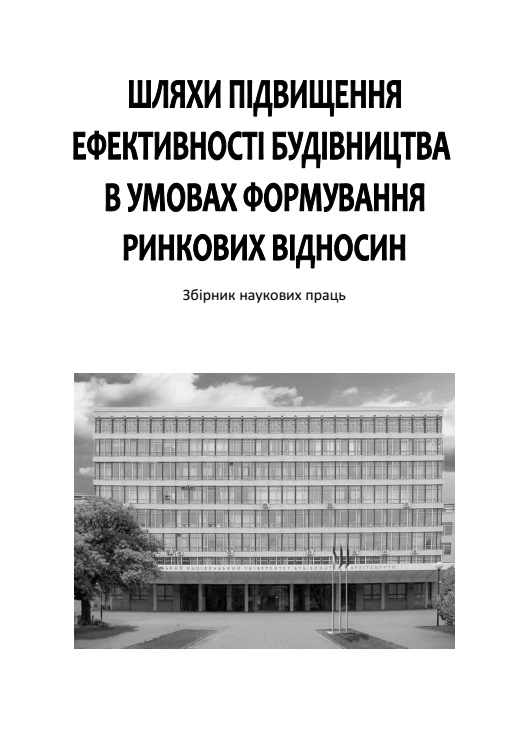Методичний підхід до оптимізації витрат будівельних підприємств в умовах невизначеності
DOI:
https://doi.org/10.32347/2707-501x.2014.31.76-84Keywords:
resource-consuming, fuzzy optimization, fuzzy goals, fuzzy constraints, the membership function, the optimal solution.Abstract
The basic directions of using the theory of fuzzy optimization to improve financial planning and monitoring of its implementation of construction enterprises. The methodical approach to determining the optimal level of costs UAH 1 construction products under fuzzy information about the objectives and constraints.
References
Ізмайлова К. В. Фінансовий аналіз у будівництві: навч. посіб. – К.: МАУП, 2007. – 236 с.
Орловский С.А. Проблемы принятия решений при нечеткой исходной информации. – М.: Наука, 1981. – 208 с.
Оценка управленческих решений реализации инвестиционного проекта с учетом неопределенности / М. А. Прилепова // Вісник Придніпровської державної академії будівництва та архітектури. – Д.: ПГАСА, 2012. – № 10. – С. 60 − 64.
Рентабельність операційної діяльності великих та середніх підприємств за видами економічної діяльності [Електронний ресурс] / Держкомстат України. – Режим доступу: httр://ukrstаt.gоv.uа
Саммаха Бассам. Моделирование организации строительства с помощью теории нечетких данных (в условиях смешанной экономики Ливана) / Бассам Саммаха // Містобудування і територіальне планування. – 2005. – Вип. 20. – С. 299–304.
Сорокіна Л.В. Моделі і технології управління ринковою вартістю будівельних підприємств [монографія] / Л.В. Сорокіна – К.: ТОВ «Лазурит-Поліграф», 2011. – 541 с.
Скакун В. А. Стратегічне управління логістичними бізнес-процесами будівельних підприємств: пріоритетні задачі та шляхи їх вирішення / В. А. Скакун, А. Ф. Гойко // Коммунальное хозяйство городов – Вып. 87. – Серия: Экономические науки. – К.: техніка, 2009. – С. 172–178.
Формалізація цінностей зацікавлених сторін проектів засобами теорії нечітких множин / О. М. Медведєва // Вісник Придніпровської державної академії будівництва та архітектури. – Д.: ПДАБА, 2012. – № 9. – С. 25 − 33.
Штовба С.Д. Проектирование нечетких систем средствами МАТLАВ. – М.: Горячая линия. – Телеком, 2007. – 288 с.
Фінансова звітність емітентів: [Електронний ресурс] // Режим доступу: www.smida.gov.ua
Черняк О.І. Інтелектуальний аналіз даних: підручник. – К.: Знання, 2014. – 599 с.
Sorokina L.V. Application of fuzzy inference algorithm of the Suggeno type for managing financial flows of building companies/ Л.В. Сорокіна // Актуальні проблеми економіки. – 2010. – № 11 (113) – C. 247 – 255.
Elmer P. Dadios Fuzzy Logic – Algorithms, Techniques and Implementations/ Edited by Elmer P. Dadios. – Croatia, 2012: [електронний ресурс] : // Режим доступу : www.intechopen.com
Terano T, Asai K., Sugeno M., Fuzzy Systems Theory and its applications, Academic Press, London 1992.
Zadeh L. A., Bellman R. E. Decision-making in a fuzzy environment. – Managem. Sci., 1970, 17, p. 141 – 164.
Downloads
How to Cite
Issue
Section
License
Copyright (c) 2020 Л. В. Сорокіна, А. Ф. Гойко

This work is licensed under a Creative Commons Attribution 4.0 International License.
Authors who publish with this journal agree to the following terms:
- Authors retain copyright and grant the journal right of first publication with the work simultaneously licensed under a Creative Commons Attribution License that allows others to share the work with an acknowledgement of the work's authorship and initial publication in this journal.
- Authors are able to enter into separate, additional contractual arrangements for the non-exclusive distribution of the journal's published version of the work (e.g., post it to an institutional repository or publish it in a book), with an acknowledgement of its initial publication in this journal.
- Authors are permitted and encouraged to post their work online (e.g., in institutional repositories or on their website) prior to and during the submission process, as it can lead to productive exchanges, as well as earlier and greater citation of published work (See The Effect of Open Access).

